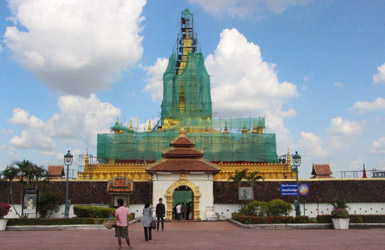Vientiane authorities are preparing many activities for the 450th anniversary celebrations of the national icon, the That Luang stupa, next month with its restoration set to be complete on time.
A meeting to discuss preparations for the stupa’s 450th anniversary celebrations took place in the capital on Friday and was attended by Vientiane Mayor Dr Sinlavong Khoutphaythoune, Minister of Information, Culture and Tourism Prof. Dr Bosengkham Vongdara, other officials, monks and novices.
Prof. Dr Bosengkham Vongdara said this year’s celebrations were very important as they mark a historic milestone – the 450th anniversary of the That Luang stupa’s construction.
The organising committee said the celebrations would be held during the That Luang Festival with many activities and the night fair running from November 12-14. The activities include the wax castle procession, to include 450 of the colourful structures, as well as the traditional game of tikhy (similar to hockey) between the country’s leaders and officials.
However, the highlight will be the completion of the That Luang stupa restoration project with the project committee confirming that repairs to the stupa would be completed ahead of the festival.
The restoration involves work to improve the main structure, paintwork, surrounding garden, drainage channels, electrical system and other features, notably the gold leaf to be placed on the top of the stupa.
This morning Vientiane authorities started to place more than 10 kilogrammes of gold leaf on the central spire.
During the That Luang Festival large numbers of local folk and visitors can be seen carrying silver bowls with flowers, candles and incense walking towards the That Luang esplanade to pay homage to the grand golden stupa and the sacred artefacts that surround it.
There will also be a street fair, along with performances by Lao artists and traditional dance shows.
One of the main rituals is for people to give offerings around the That Luang Stupa on the last day of the festival.
The stupa was originally built during the ancient Khmer civilisation, when Vientiane was inhabited by people known as the Cham. Researchers believe the structure was originally a four-sided stone obelisk.
The site was built as a place for people to worship and pray to idols.
The structure was renovated on the orders of King Xay setthathirath in the 16th century when the original site was covered with a bigger stupa. From then on the monument took the name That Luang, or Grand Stupa.
The Cham period saw the second wave of Buddhism in Laos. Under the patronage of Emperor Ashokka of India, the venerable monks Sona and Outala and five scholars brought what believers understand to be pieces of the pelvic bone of Lord Buddha to Vientiane in the Buddhist calendar year 218 (BCE), when they were stored at Phou Luang hill.
The ruler of Vientiane at that time, Lord Chanthabouly Phasitthisack, had a stupa built over the obelisk in 236 BCE. The sacred site was then named Pha Chedi Lokachulamany.
According to the legend of the That Phanom Stupa, also known as Tamnan Oulangkhathat, Emperor Ashokka authorised the relics to be placed inside the That Luang stupa in Vientiane.
The same legend claims that the remains of Lord Buddha were distributed to all corners of the globe where there were Buddhist followers and his ashes were placed inside 84,000 stupas. This number corresponds to the 84,000 points that believers are required to study in the tripitaka (Buddhist scriptures).
Source: Vientiane Times



